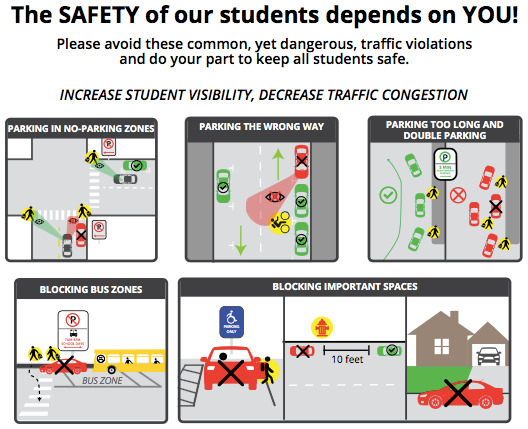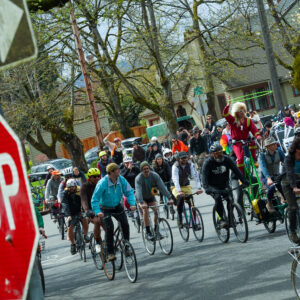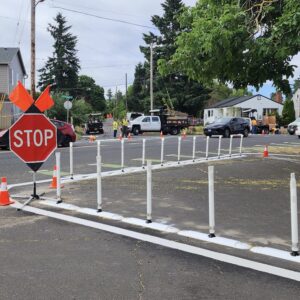Sometimes the streets that should be safe for the whole family are unfortunately the most stressful.
Neighborhood Greenways are one example. Because they lack stop signs and are often adjacent to gridlocked arterials, they are increasingly saturated with cut-through drivers. And consider the streets in front of schools. Because too many people use cars — often with complete lack of respect for other road users — streets near schools can be a chaotic, dangerous mess two times every day.
The Portland Bureau of Transportation (PBOT) is well aware of this problem. The lack of safety during pick-up and drop-off makes the city’s goal of encouraging more people to bike and walk to school much harder. That’s why the city is launching a new safety campaign aimed at taming this daily street snarl.
Advertisement
Under the new plan, PBOT’s Safe Routes to School team will work with the school community and principal to identify problem spots. Then they’ll find volunteers (a.k.a. “champions”) for the campaign. Using a series of new educational materials, city staff will empower moms, dads, and other caregivers to take an active role in policing their streets. School principals will help make sure the campaign fits with the school’s individual needs.
“The goal of the program is to work with schools and the school community to implement an education campaign to cut down on the most common pick-up and drop-off behaviors that are unsafe,” says PBOT Communications Director John Brady.
Volunteers will be encouraged to educated caregivers by having conversations with them and using a series of educational posters that explain Oregon laws. PBOT will also supply a “parking enforcement tally sheet” to keep track of illegal behaviors and track progress.
PBOT says the campaign will launch at Buckman School in southeast Portland next week.
— Jonathan Maus: (503) 706-8804, @jonathan_maus on Twitter and jonathan@bikeportland.org
Never miss a story. Sign-up for the daily BP Headlines email.
BikePortland needs your support.










Thanks for reading.
BikePortland has served this community with independent community journalism since 2005. We rely on subscriptions from readers like you to survive. Your financial support is vital in keeping this valuable resource alive and well.
Please subscribe today to strengthen and expand our work.
I don’t have kids, but have seen this firsthand several times when I lived near the Beach school, and it’s a wonder that nothing serious has happened.
If it’s easy to predict the outrage over challenging the supremacy of driving convenience, then it’s still difficult to understand how we allowed it to be normalized in this setting.
“The goal of the program is to work with schools and the school community to implement an education campaign to cut down on the most common pick-up and drop-off behaviors that are unsafe,” says PBOT Communications Director John Brady.
The most common pick-up and drop-off behavior that is unsafe is driving your kid to school – especially is you drive your kid all the way there as opposed to stopping a few blocks away. Why is PBOT only focusing on the letter of the law when doing an education (as opposed to enforcement) campaign? They should be far more ambitious, asking people to do things that would actually make it feel comfortable to bike and walk to school:
-Minimize driving to school (carpool, bus, bike or walk!) Although I understand why you might not want to headline with it, because it could make the target population tune out, it should be somewhere in the communication.
-If you drive and your child (and you, if needed) can easily walk a few blocks, don’t drive all the way to the school! Stop at least three blocks away and have your child walk from there. This minimizes the negative impact you have on other families and on school buses. It also means you don’t have to sit in school traffic. This seems huge to me. School pickup and dropoff could be so much more efficient and comfortable this way even if the same absurd number of parents still drive their kids to and from school.
-Avoid driving on common bike/walk routes to school (show sharrow, bike navigation sign, crosswalk graphics).
Great advice. We drive our middle-schooler because his route goes through 4 or 5 terrible intersections, including crossing Highway 26. But we’d have to be CRAZY to take him to the school drop-off line. We drop him in a nearby neighborhood and let him walk the last part.
I’d love to see PBoT and the schools normalize this by taking away parking near the school for all but those with disabled parking placards. Even pushing the drop-offs a block away can dramatically reduce the density of cars.
We presented a plan at our elementary school transportation forum a couple of years ago with a map of suggested ‘alternate drop spots’ for parents. There were about 10 suggested points on the map where parents could drop their kids on the right-hand side of the road and loop out of the area heading left (to avoid crossing the path of kids during the drop-off). BSD thought the plan was really interesting and they said they would consider it as something to present district-wide, but nothing has come of it so far. As far as we can tell, nobody is using any of these drop spots. I think parents figure, ‘I’ve driven them this far, may as well take them all the way’.
“The safety of our students depends on you”. It would be nice if PBOT would install 20 mph school speed limit signs on 116th Ave. (currently 25 mph signage) for the West Powellhurst grade school at the end of the street. Also, a little cross walk where there is none (there is a crosswalk sign), and perhaps some ADA ramps where the crossing should be. Infrastructure compliments school zones. Not feeling the Love for East Portland.
The BS that occurs in front of Franklin HS every morning is ridiculous. If I’m ever hit by a car, it will be by some clueless, double parking, frustrated parent in front of that school between the hours of 7:30 and 8:30am…
I just do not understand the parents driving those cars! Why don’t they just drop off on 50th, 51st, or SE Franklin St. and completely avoid the traffic and madness on 52nd and Woodward? It would certainly be less stressful, and I bet it would be faster too.
We have parents sit in our elementary drop-off queue for 10 or 15 minutes. They could easily park a block away and save time! I guess that’s what we get for designing our schools like drive-ins.
The power of habits — make people stop thinking about their choices. If everyone had to park a couple of blocks away and walk to the school, everyone would be better off, including the parents.
This sounds like Taco Bell. I’ve parked, gone in, ordered, and walked back the car with my “food” long before the car I took note of at the end of the drive-thru line gets to the pick-up window.
at least there’s no more looping driveway out front…
I’d like to see police stake out school zones and, frankly, stalking and harassing cell-phoning/texting parents to intimidate them out of their homicidal habits.
The diagram clearly illustrates why parking near an intersection creates a dangerous situation caused by poor sight lines. Can we just start enforcing ORS 811.550(17)? Not just near schools, but all over the city. Sell it as greater safety and convenience for all modes.
Exactly.
I cannot comprehend why Portland has chosen to normalize this behavior with their refusal to enforce the law. We could hire any number of parking enforcement staff and the fines would more than cover their salaries. Unfortunately, Portland continues to prioritize on-street parking above nearly everything else.
I am not in favor of enforcing this law only around schools, but it’s as good a place to start as any. Intersection visibility is a danger to all modes of transportation and as far as I’m concerned should be the first priority of any administration interested in providing more than lip service to safety for its residents.
Much of the City’s own signage including around schools indicates parking less than 20′ from the crosswalk (painted or not) contrary to this diagram and ORS 811.550(17) and (18). The City bringing its signage and enforcement into compliance with its diagram and the law would seem to be a no-brained, and long overdue.
Education is great, but enforcement is required. “I’m only here for a minute” will likely be the self-rationalization for most parents/drivers to continue this behavior … even when educated.
IMO a more effective, or supplemental, action ought to include infrastructure changes to the street which can be simply done with road paint. Enforced “no parking” areas adjacent the curb [think ‘airport pickup’]; even pro tem implementation of one-way flow immediately adjacent a school during the morning and afternoon rushes.
I bet my local school – Sunnyside – could easily find enough parent volunteers to run this show, especially since there are a high rate of walker and biker students here.
I’d be happy to work with PBOT, ALTA, or whomever to come up with a school street configuration that enhances safety, period.
Thankfully PBOT is in the midst of a large project that will identify infrastructure projects at schools across the city. The top priority projects will be implemented with Fixing Our Streets dollars, and the balance of the project list will help PBOT pursue newly passed SRTS funding from HB 2017 and other sources. Yes, infrastructure improvements are needed along many school routes across the city (hear that West Powellhurst comment!), so thankfully they’re doing something about it! Info here: https://www.portlandoregon.gov/transportation/article/625882
At Beach School, people driving use N Blandena as a shortcut to drop off at the southeast corner. or turn north on to Concord and drop off at the playground. Driving east on N Blandena is very dangerous because there is a steady stream of kids walking and riding bikes and scooters north along Concord, and because this is right at the school, they are often crossing this intersection back and forth to meet friends, etc. For people driving, the crosswalk is almost completely blocked. A large laurel hedge obscures the sidewalk to the south, and the school is built right to the lot line in the north corner (N Blandena is built similar to an alley). The obvious and safest solution is to make this short street one way westbound. At a minimum, PBOT should paint a parking line here to indicate where to stop since the sidewalk is completely obscured, it is difficult to know where to stop until someone steps out from behind the hedge/building. I have requested this several times….
driving children to school is inherently unsafe from a public health perspective. in addition to a focus on safety portland should be disincentivizing driving to school all together.
Once again, it appears Portland will try anything except for ENFORCEMENT. Every day, I see motorists blowing the red light at Powell and 26th Avenue right in front of Cleveland High School. But, no. We try enforcement of the unnecessary stop signs at Ladd’s Addition. A red light camera at this location would be appropriate!
Although this driving behavior is a problem, this isn’t why folks aren’t biking to school with their kids. Why don’t families bike? Picture yourself biking to school by yourself while simultaneously watching over 1 or 2 elementary school age children – 1) the greenways aren’t safe enough – we need more barriers to disincentevize drivers from using them; 2) the greenways cross major streets that have green bike crosswalks that drivers ignore if you’re lucky, or often no crosswalk at all, these are quite scary with kids – we need signaled crosswalks at ALL of these intersections; 3) kids bikes get stolen from school, you can’t leave that islabike out front all day with any confidence – we need secure parking at the schools, like a shared cage or bike lockers
I understand why some parents drive their kids to school. The route to school may be too unsafe given the child’s age (how many parents would like to see their third grader waking across Powell every day?). The hours of school, including after school activities, may have the child leaving and returning in the dark (especially returning). The child may go to a school a considerable distance from his home (magnet school, intra-district transfer, private or parochial school).
At one school my kids went to, there were two teachers monitoring drivers in the drop off area. They saw any unsafe driving or cellphone usage, blew a whistle, pointed out the parent, gave then a taking to, and escalated repeat offenders to parent groups and administration. No parent wants to get called out in front of their kid’s whole class, so this was very effective. We lived 30 minutes’ drive from that school, and there was no bus option, so my kids got driven. At another school my son went to, there was a well-known established system for drop off. All school traffic went one-way on the street, even though the street was two-way, there was no passing of a stopped car. This was also very effective. We lived only 10 blocks away, my son walked or biked or skateboarded to school.
A school is a community, and a pretty tight knit one. The most effective enforcement comes from within that community. A school that has a drop-off/pick-up problem should have teachers in orange vests directing traffic with whistles, post signs telling parents where to go, distribute clear directions with the behavior expected, send home flyers in backpacks, have room parents involved, etc. If the school’s administration and parent group is assertive and puts the effort in, they can control parent-driver behavior much more effectively than can police. If the school’s administration doesn’t make the effort, then . . .
Whatever effort PBOT makes, it will work much better if the school administration, teachers, and parents are very closely involved.
PBOT should work with PPS on school boundaries. I live in Overlook, but my kid is supposed to attend Roosevelt. Grant and Lincoln are much closer and much more accessible by bike or transit.I have biked to Roosevelt and the route is fraught with horrible infrastructure- no way my kid is riding a bike there.
That’s a pretty long haul for a high schooler, but a very nice ride! You should check it out, again: N. Concord to N Bryant to N Wabash to N Halleck/Kilpatrick to N Dana to N Houghton; you have to cross the cut at Lombard, and then you are there. I love this ride. Riding on the neighborhood greenways and the street grid in this part of N. Portland is ultra-chill.
I have been surprised this year by parents temporarily parking on the wrong side of the road to drop their kids off.
I also think that all of the intersections within several blocks of a school should have stop signs.
This morning as our youngest was biking off to school, drivers stopped for him at the intersection by our house to let him cross. Another driver behind the driver on the left honked and went around the stopped car and tried to go through the intersection as our son was crossing. This driver was in a hurry to take his child to school (I recognized him as a local parent).
You know, some of this stuff ought to be just basic common sense: It’s school time. You are 4 blocks from the school. A car stops in front of you by an intersection. Gee, I wonder WHY?? If you don’t know the answer, and think that the reasonable thing to do is honk and drive around them, you aren’t doing life very well.
make a note of every child whose parent breaks the law and put all those kid’s names in the newsletter… the kids will shame their parents…
I’d prefer a method that doesn’t single out the kids and look like public shaming. What about flow education at the classroom level? Then the kids would have a strong idea as to what it’s supposed to look like. They can encourage and direct their parents from a positive angle.
It worked for recycling. http://www.tandfonline.com/doi/abs/10.1080/00219266.1996.9655512
I used to work at a private school where most parents drove (it was in a suburb and most families were in the city). The school did have a small bus (bus and bike commuters had a different entrance) and highly encouraged carpooling.
There was a tightly regimented pickup routine, regulated by the librarian armed with a megaphone and her best middle school classroom management voice. New parents were inducted into the routine by more experienced parents and letters home/parent night info sessions. There was clear signage and teachers or older students also escorted kids to their cars. Parents were shamed, loudly, and publicly, on the megaphone. Many of the parents I talked to confessed their fear of the librarian–and that it kept them on their toes during carpool.
It was quite the endeavor but at least no kid was ever struck by a car. Surely Portland area schools can incorporate some of these elements?